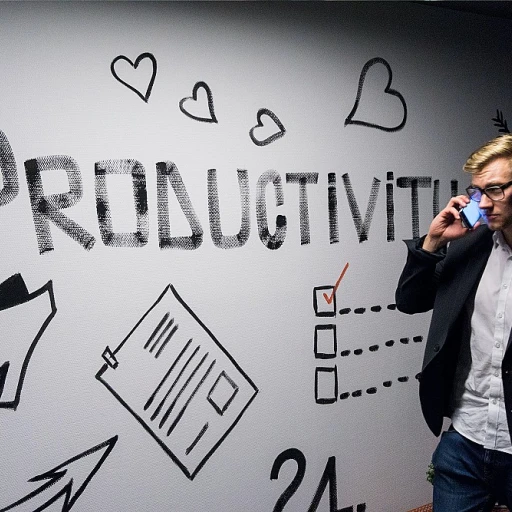
Understanding the concept of an intelligent workplace
Defining Intelligence in the Modern Workplace
When we talk about an intelligent workplace, we’re not just referring to a space filled with the latest technology. Instead, it’s about creating a work environment where digital tools, data, and human collaboration come together to enhance productivity and employee experience. An intelligent workplace uses smart solutions and workplace technology to streamline tasks, improve decision-making, and support both in-office and hybrid work models.
Core Elements of an Intelligent Workspace
Today’s workplaces are evolving rapidly. The integration of cloud computing, machine learning, and data analytics allows organizations to manage resources, people, and information in real time. This shift isn’t just about efficiency; it’s about empowering employees to work smarter, not harder. Features like desk booking, room booking, and visitor management systems help optimize office space and adapt to the needs of hybrid workplaces.
- Digital tools: Collaboration tools and booking software make it easier for teams to connect and manage their work, whether they’re remote or on-site.
- Data-driven decisions: Access to workplace data helps management identify trends, improve processes, and create a more responsive work environment.
- Employee-centric design: Solutions that prioritize employee experience, such as flexible workspace options and seamless technology integration, contribute to a more intelligent workplace.
Why Intelligence Matters at Work
Intelligent workplaces are better equipped to adapt to change, support diverse work styles, and foster collaboration. By leveraging workplace solutions and digital tools, organizations can create environments that not only enhance productivity but also boost morale and engagement. For those interested in practical ways to improve workplace culture and motivation, exploring affordable strategies to enhance workplace morale can offer valuable insights.
As we move forward, understanding what makes a workplace intelligent sets the foundation for exploring how professional mentoring and other strategies can further shape and support these dynamic environments.
The role of professional mentoring in shaping intelligent workplaces
The Influence of Mentoring on Smart Workplaces
Professional mentoring plays a pivotal role in shaping an intelligent workplace. As organizations adopt digital tools, cloud computing, and data analytics, the need for employees to adapt and thrive in these environments becomes more urgent. Mentoring bridges the gap between traditional work practices and the demands of a modern, technology-driven office.
Mentors help employees navigate new workplace technology, from collaboration tools to desk booking and room booking systems. They provide guidance on using digital solutions for real time communication, hybrid work arrangements, and visitor management. This support enhances productivity and fosters a culture where continuous learning is valued.
- Knowledge Transfer: Mentors share expertise in data-driven decision making and the use of intelligent workplace systems, making it easier for employees to leverage workplace solutions effectively.
- Adapting to Change: With hybrid workplaces and flexible office space becoming the norm, mentors help employees adjust to new work environments and digital workflows.
- Boosting Collaboration: Through mentoring, employees learn to maximize collaboration tools, improving teamwork and communication across digital and physical spaces.
- Supporting Employee Experience: Mentoring enhances the employee experience by building confidence in using smart technology and workplace management systems.
Organizations that prioritize mentoring see measurable improvements in how employees interact with intelligent workspace tools and systems. This, in turn, leads to smarter management of tasks, better use of data, and more effective hybrid work strategies. For practical insights on implementing these approaches, explore effective strategies for employee mentoring.
Key characteristics of an intelligent workplace
Core Elements of a Smart Work Environment
What sets an intelligent workplace apart is not just the adoption of digital tools or the presence of advanced technology. It’s the way these elements come together to create a seamless, adaptive, and empowering environment for employees. Here are some defining features that shape truly intelligent workplaces:
- Integrated Digital Tools and Systems: Intelligent workplaces leverage workplace technology such as collaboration tools, desk booking, room booking, and visitor management systems. These solutions streamline daily tasks, making it easier for employees to manage their work environment and focus on high-value activities.
- Data-Driven Decision Making: The use of data analytics and real time insights helps management and teams make informed decisions. Whether it’s optimizing space with booking software or improving employee experience through feedback systems, data is at the core of every smart workplace.
- Flexible and Hybrid Work Models: Intelligent workplaces support hybrid work, allowing employees to move seamlessly between office and remote environments. Cloud computing and digital workplace solutions enable access to information and collaboration from anywhere, enhancing productivity and work-life balance.
- Personalized Employee Experience: Smart workplaces use machine learning and intelligent workspace solutions to tailor the environment to individual needs. From personalized desk booking to adaptive lighting and climate controls, technology enhances comfort and efficiency.
- Enhanced Collaboration and Communication: Modern collaboration tools and workplace solutions break down silos, making it easier for teams to connect, share knowledge, and innovate. This fosters a culture of continuous learning and collective problem-solving.
These characteristics are not just about technology—they reflect a shift in mindset. Empowering employees, sharing power, and encouraging autonomy are essential. For a deeper look at why great leaders often share power with their teams, you can explore this article on leadership and empowerment. Ultimately, an intelligent workplace is one where people and technology work together to create a dynamic, responsive, and supportive work environment.
Challenges in fostering intelligence at work
Barriers to Building a Smart Work Environment
Creating an intelligent workplace is not just about adopting the latest digital tools or implementing advanced workplace technology. Organizations often encounter several obstacles that can slow down or even block progress toward a truly intelligent workspace.- Resistance to Change: Employees and management may be hesitant to adopt new systems, such as cloud computing, machine learning, or data analytics. This reluctance can stem from a lack of understanding, fear of job displacement, or simply being comfortable with existing processes.
- Fragmented Digital Solutions: Many workplaces use a mix of collaboration tools, desk booking software, and visitor management systems that do not always integrate smoothly. This fragmentation can hinder real time collaboration and reduce the overall effectiveness of workplace solutions.
- Data Overload: Intelligent workplaces rely on data-driven decisions. However, without proper management, the sheer volume of data generated by digital tools can overwhelm employees and make it difficult to extract actionable insights.
- Hybrid Work Complexities: The shift to hybrid work models introduces new challenges in maintaining a consistent employee experience. Ensuring that both remote and in-office employees have equal access to intelligent workspace resources, such as room booking or booking software, requires careful planning and robust systems.
- Security and Privacy Concerns: With increased reliance on digital and cloud-based workplace technology, protecting sensitive employee and company data becomes more complex. Balancing convenience with security is a constant challenge.
- Skill Gaps: Not all employees are equally comfortable with new technology. Upskilling and continuous training are necessary to ensure everyone can leverage intelligent workplace tools to enhance productivity and collaboration.
Why These Challenges Matter
If these barriers are not addressed, organizations risk missing out on the full benefits of intelligent workplaces. Employees may feel disconnected, digital investments may not yield expected returns, and the overall work environment can become less adaptive and innovative. Overcoming these challenges requires a thoughtful approach to change management, investment in user-friendly workplace solutions, and a commitment to ongoing professional mentoring and support.Mentoring strategies to enhance workplace intelligence
Practical Approaches to Mentoring for Smarter Workplaces
Mentoring is a powerful driver for making a workplace more intelligent. To truly enhance productivity and foster a culture of learning, organizations need to adopt mentoring strategies that fit the realities of today’s digital and hybrid work environments. Here are some effective approaches:- Leverage digital tools for mentoring: Use collaboration tools, cloud computing platforms, and workplace technology to connect mentors and mentees, even across different office locations or remote setups. Digital solutions like desk booking and room booking software can also facilitate in-person sessions when needed.
- Integrate data analytics into mentoring: Encourage mentors and mentees to use data analytics to track progress, set measurable goals, and identify skill gaps. Real time feedback systems and workplace management platforms can help visualize growth and inform next steps.
- Promote cross-functional collaboration: Intelligent workplaces thrive on diverse perspectives. Pair employees from different departments or with varied expertise to foster knowledge sharing and creative problem-solving. This approach also helps employees adapt to new workplace solutions and technologies.
- Support hybrid work mentoring: In a hybrid work environment, ensure mentoring is accessible to all employees, regardless of where they work. Use digital tools for regular check-ins and provide resources for both in-person and virtual interactions to maintain strong connections.
- Encourage peer-to-peer mentoring: Not all mentoring needs to be top-down. Peer mentoring can empower employees to share insights about new systems, digital tools, or smart office solutions, building a more collaborative and intelligent workspace.
- Focus on continuous learning: Intelligent workplaces are always evolving. Encourage mentors to guide employees in searching for new knowledge, experimenting with workplace technology, and staying updated on trends like machine learning and visitor management systems.
Measuring the impact of mentoring on workplace intelligence
Evaluating Mentoring’s Influence on Workplace Intelligence
Measuring the impact of professional mentoring on an intelligent workplace requires a blend of qualitative and quantitative approaches. As organizations adopt digital tools, hybrid work models, and smart workplace solutions, it becomes essential to assess how mentoring shapes employee experience and enhances productivity.- Employee Feedback and Engagement: Regular surveys and feedback sessions help capture how employees perceive mentoring’s effect on their skills, collaboration, and adaptation to new workplace technology. These insights reveal shifts in engagement and satisfaction, especially in hybrid work environments.
- Performance Metrics: Tracking key performance indicators (KPIs) such as project completion rates, innovation in tasks, and use of digital collaboration tools can highlight the real-time benefits of mentoring. Improvements in these areas often signal a more intelligent workspace where employees leverage technology and data analytics effectively.
- Adoption of Digital Tools: Monitoring the uptake of systems like desk booking, room booking, and visitor management software can indicate how mentoring supports employees in navigating new workplace solutions. High adoption rates suggest that mentoring is successfully bridging the gap between traditional office routines and digital transformation.
- Knowledge Sharing and Collaboration: Analyzing collaboration patterns—such as participation in team meetings, use of cloud computing platforms, and sharing of best practices—can show how mentoring fosters a culture of continuous learning and smart management.
- Retention and Growth: Data on employee retention, internal mobility, and professional development can be linked to mentoring initiatives. When employees feel supported in their growth, they are more likely to stay and contribute to an intelligent workplace.
| Measurement Area | Relevant Tools & Data | Impact on Intelligent Workplaces |
|---|---|---|
| Employee Experience | Surveys, engagement platforms | Improved satisfaction and adaptability |
| Productivity | Task management systems, performance dashboards | Enhanced efficiency and output |
| Digital Adoption | Usage analytics, booking software data | Greater use of workplace technology |
| Collaboration | Collaboration tools, cloud computing logs | Stronger teamwork and knowledge sharing |
| Retention | HR systems, exit interviews | Lower turnover, higher loyalty |












